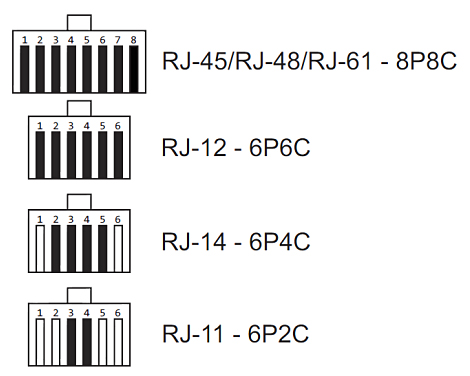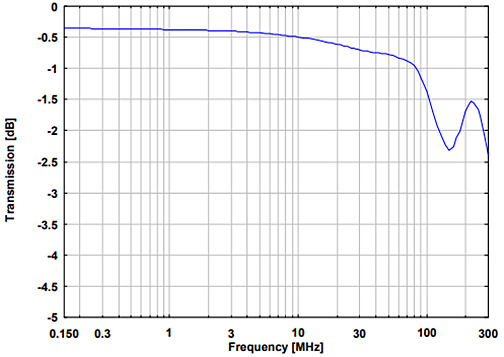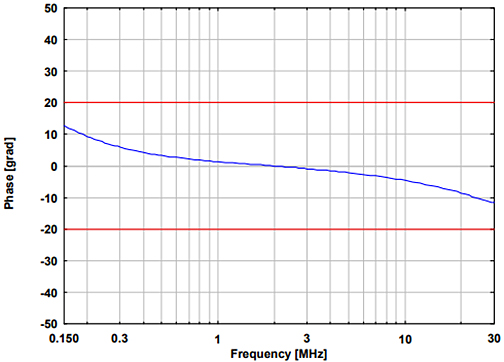Schwarzbeck NTFM 8158 Overview
The Schwarzbeck NTFM 8158 allows to perform common mode disturbance voltage measurements on unshielded twisted pairs (UTP) or communication ports with 2, 4, 6 or 8 wires according to CISPR 22:2005 or EN 55022:2006. The Equipment under Test (EuT) or Auxiliary Equipment (AE) can be connected using the RJ-45 sockets. The pin assignment follows EIA/TIA-T568A/B. The electrical circuit of NTFM 8158 is designed according to CISPR 22 Edition 5.2, figure D.3. The ISN does not influence the transmission quality up to gigabit Ethernet.
[split]
The ISN-device NTFM 8158 provides an longitudinal conversion loss of typically 75 dB at the EuT port and allows to measure CAT6 devices. There are two further ISN available for measurements of CAT5 devices (CAT5 8158) and CAT3 devices (CAT3 8158) respectively.
In addition to the measurement of disturbance voltage the NTFM 8158 allows to perform measurements of conducted immunity acc. CISPR 24 or EN 55024 up to 80 MH. An additional 50 Ohm to 150 Ohm adapter (EAB8 50-150) acc. IEC 61000-4-6 is required. This adapter can easily be mounted to the NTFM 8158 and is available as an option.
The specification of NTFM 8158 is fully compliant to CISPR 22 Ed. 5.2 and verified according methods described in CISPR 16-1-2, Annex E.
Application
The telecommunication port of the device under test must be connected to the NTFM 8158 EuT-port. The NTFM 8158 provides the asymmetrical port termination of the EuT. Auxiliary Equipment (AE) which has to be operated together with the device under test must be connected to the AE-port of NTFM 8158.
The data communication is based on differential mode voltages on pairs of wires. If the virtual null in the electrical middle of the voltages shifts compared to reference ground the magnitude of this shift is called the asymmetrical disturbance voltage or the common mode voltage. This voltage is decoupled to the BNC-connector to be measured with a receiver. The nominal voltage division factor is 9.5 dB, i.e. the reading of the voltage at a 50 Ohm receiver has to be increased by 9.5 dB. This results into the disturbance voltage.
The LCL describes the conversion of the wanted differential mode data signal along a transmission line into an unwanted common mode signal. The common mode signal could be radiated and might cause disturbance field strength.
The test set up is described in CISPR 22 more detailed. Special attention must be paid to low inductive grounding, i.e. grounding suitable for radio frequencies. This is achieved by placing the aluminium housing of the NTFM 8158 directly on the reference ground plane. The EuT cable and the AE cable must not be installed close or parallel to each other to avoid unwanted coupling between them.
Pin assignment
The Pin Assignment complies to EIA/TIAT568A/B. RJ-12 and RJ-14 connectors use pair 1 and pair 3, RJ-11 connectors use pair 1 of the RJ-45 jack which are located in the middle of the RJ-45 connector. Pins 1 and 6 of the RJ-12 are not useable then. Please note that using RJ-12, RJ-11 or RJ-14 connectors in RJ45 jacks leads to decreased lifespan of the RJ-45 jack.
If less than four pairs are measured, the unused wires are left unconnected.
| Paar/pair | PRJ-45 connector | RJ-12/RJ-14 connector | RJ-11 connector |
| 1 | Pin 4+5 | Pin 3+4 | Pin 3+4 |
| 2 | Pin 1+2 | - | |
| 3 | Pin 3+6 | Pin 2+5 | |
| 4 | Pin 7+8 | - |

Attention!
Don’t connect 6PxC plugs to the 8P8C jack of the NTFM 8158. The outer pins will bend. Only a few femtofarads will change the very sensitive LCL especially of the CAT 6 device.
Furthermore take care that the bottom of the ISN stays free from labels and always keep it clean since it is the connection to ground
 |
 |
| Abb. 2 Transmission Differential Mode Signal AE-EuT | Abb. 3 Entkopplung/Decoupling AE - EuT |
 |
 |
| Abb. 4 Longitudinal Conversion Loss (LCL) | Abb. 5 Transmission EuT to Measurement Port |
 |
 |
| Abb. 6 Common Mode Impedance (Magnitude) at EuT-Terminals | Abb. 7 Common Mode Impedance (Phase) at EuT-Terminals |
| Schwarzbeck NTFM 8158 Specifications | ||
| Frequency range (ISN) | 9 kHz - 30 MHz | |
| Frequency range (CDN) | 150 kHz – 80 MHz | |
| Type | T8, T4, T2-ISN, CDN (EAB8 50-150 required) |
|
| Insertion loss: differential mode AE - EuT port | typ.: < 1 dB 100 kHz to 30 MHz typ.: < 2.5 dB 30 MHz to 250 MHz (Fig.1) |
|
| Decoupling AE-EuT | >55 dB (Fig.2) | |
| Longitudinal Conversion Loss (LCL) | 75 dB @ 150 kHz 59 dB @ 30 MHz (Fig.3) |
|
| Voltage division factor for asymmetrical voltage | 9.5 dB ± 1 dB (Fig.4) | |
| max. RF-voltage EuT | 15 V | |
| max. RF-voltage measurement port (BNC) | 25 V | |
| Impedance (asymm.) | ≤30 MHz: 150 Ohms ± 20 Ohms (Fig.5a) >30 MHz: 150 Ohms + 60 Ohms/ -45 Ohms≤ |
|
| Connectors AE, EuT | RJ-45 (8P8C) | |
| Current max | 800 mA (pair) | |
| Max. voltage | 63 VAC / 100 VDC | |
| Measurement port | BNC 50 Ohm female | |
| Crosstalk PSELFEXT | typ.: > 66 dB 150 kHz – 1 MHz typ.: > 46 dB at 10 MHz typ.: > 38 dB at 30 MHz |
|
| Outer dimensions W x H x D | 125 mm x 62 mm x 105 mm | |
| CISPR circuit diagram | CISPR 22, Appendix D, Fig. D.3 | |







